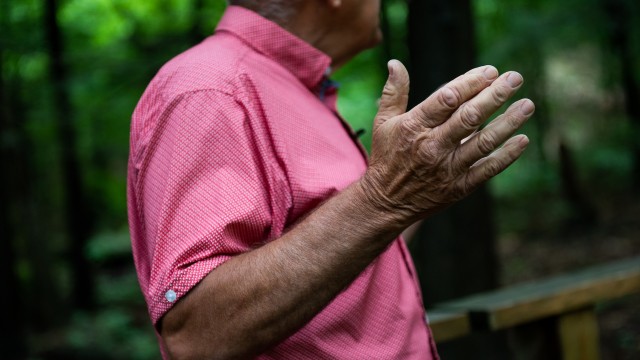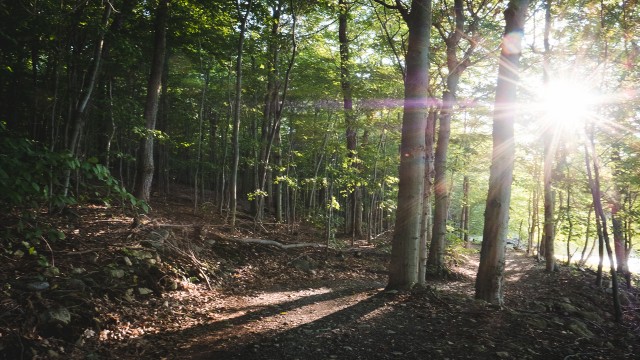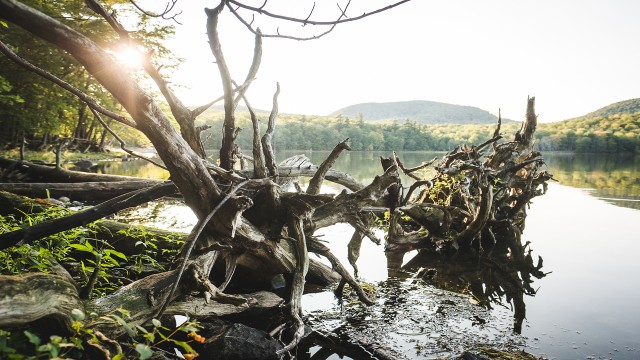Michel Durand Nolett, a member of the W8banaki community in Odanak, is incredibly knowledgeable about medicinal plants. As part of his work to pass on Indigenous knowledge, Mr. Durand Nolett kindly agreed to tell us about the history and uses of different medicinal plants that can be found on Mont Saint-Hilaire, which is located on the Ndakina, the traditional territory of the W8banaki Nation. In these videos, he introduces us to 10 medicinal plants and their properties.
We would like to remind you that, to protect the balance of our ecosystem, you should not remove any natural items from the Reserve.
Eastern White Cedar - Môlôdagw
The eastern white cedar (Thuja occidentalis) might be called a cedar in common parlance, but it’s different from the true cedars found in western Canada and Europe. The eastern white cedar is an evergreen tree that can be identified by its distinct scent and scaly compound leaves that branch out and overlap. White-tailed deer (Odocoileus virginianus) love to snack on the branches. You may already know that if you have a hedge at home!
According to expert Michel Durand Nolett, Abenaki communities used the plant to treat respiratory issues and problems in, let’s say, more delicate areas.
American Beech - Wajoimizi
The American beech (Fagus grandifolia) is one of the most common tree species on the Reserve, along with the sugar maple (Acer saccharum). Beeches are “fairly easy trees to spot because their bark is really, really smooth,” explains Michel Durand Nolett. Some people compare their grey trunks to an elephant’s foot.
Unlike most hardwood trees, American beeches keep their leaves all winter long. In the spring, the Abenaki used to gather their dry brown leaves to treat eczema.
Raspberry - Sgueskimen
Summer means raspberry season! Widely available in grocery stores, raspberries add a pop of colour to any pastry or dessert. While farmed raspberries make for an easy, abundant harvest, it's easy to spot wild raspberry bushes growing just about anywhere and everywhere—in the woods, alongside streams or even between buildings.
Well-loved for their delicious red fruit, raspberry plants (Rubus idaeus) are the perfect example of Hippocrates' famous quote, "Let food be thy medicine..." The Abenaki do just that, regularly using the plant's berries and leaves. How do they use them? Listen to Michel Durand Nolett and find out!
White Birch - Maskwamozi
The **white birch **(Betula papyrifera) is also known as the paper birch because of its white bark that peels off the trunk in sheets. The Abenaki harvested white birch bark in the spring to make containers. These containers were used to gather food and medicinal plants, but also to boil water! As long as there is still water in the container, the birch bark will not burn, explains Michel Durand Nolett.
Birch bark was also used to build canoes. Though the birches growing on the Reserve today aren’t exactly short, these trees can grow up to 25 m! Durand Nolett says that some trees were large enough that a single sheet of bark was enough to make a canoe.
Spotted touch-me-not
Spotted touch-me-not (Impatiens capensis) is a plant that grows in wetland areas such as on the shores of lakes, streams or ponds. It can grow to two metres in height. Spotted touch-me-not starts to bloom in July, and its orange flowers with their red speckles have a complex shape reminiscent of orchids.
Abenakis used spotted touch-me-not as an antidote to poison ivy (Toxicodendron radicans). Just cut the stem of a large plant, collect the sap, and spread it on the rash.
Field Horsetail - Kipskol
The horsetail is a small plant that grows in damp spots near running water. It has a bushy look to it, and is commonly called “foxtail” by Abenaki Elders, says Michel Durand Nolett.
Field horsetail can be dried and then ground to a fine powder that is used to help stem heavy bleeding. This property is due to its high concentration of silica.
Goldenrod - Wizôwatawa
Every August, the Gault Nature Reserve meadow on the purple trail transforms into a golden wonderland thanks to the endless expanse of blossoming goldenrods (Solidago spp.).
“The Abenaki used to harvest goldenrod flowers, dry them and drink them as an herbal tea to treat urinary problems,” says Michel Durand Nolett.
Narrow-Leaved Cattail
The narrow-leaved cattail (Typha augustifolia), also called narrowleaf cattail, is the smaller of the two species of cattail that grow along the edges of Quebec's waterways. The Abenaki people harvest the rhizomes, the part that is found beneath the soil, and stores the plant's nutritional reserves. The rhizomes can be milled into a flour that is used for making bread, explains Michel Durand Nolett.
The brown part at the top of the cattail has a totally different use. Watch this video to learn more.
Eastern White Pine - Koa
The eastern white pine (Pinus strobus) is the tallest tree in Eastern Canada, reaching over 30 metres high. That’s as tall as a nine-story building! We can recognize this conifer by its long needles attached in bundles of 5. Abenaki people turn toward young pine trees with slender trunks for specific medicinal purposes.
Yellow Birch
The yellow birch (Betula alleghaniensis) is Quebec’s official tree. It is commonly confused with the white birch (also known as paper birch), but you can tell them apart with one simple test: pick up a twig and scratch it. If it smells minty, you’re looking at a yellow birch.
The Abenaki would use yellow birch as an energy booster during long winter treks between camps, much like modern hikers reach for energy bars, explains Michel Durand Nolett in his video.
Learn more
This project was done in partnership with McGill University’s Indigenous Initiatives unit and the Grand Conseil de la Nation Waban-Aki. To learn more about the medicinal plants of the Ndakina, check out Michel Durand Nolett's book (in French): Plantes du soleil levant Waban Aki.


